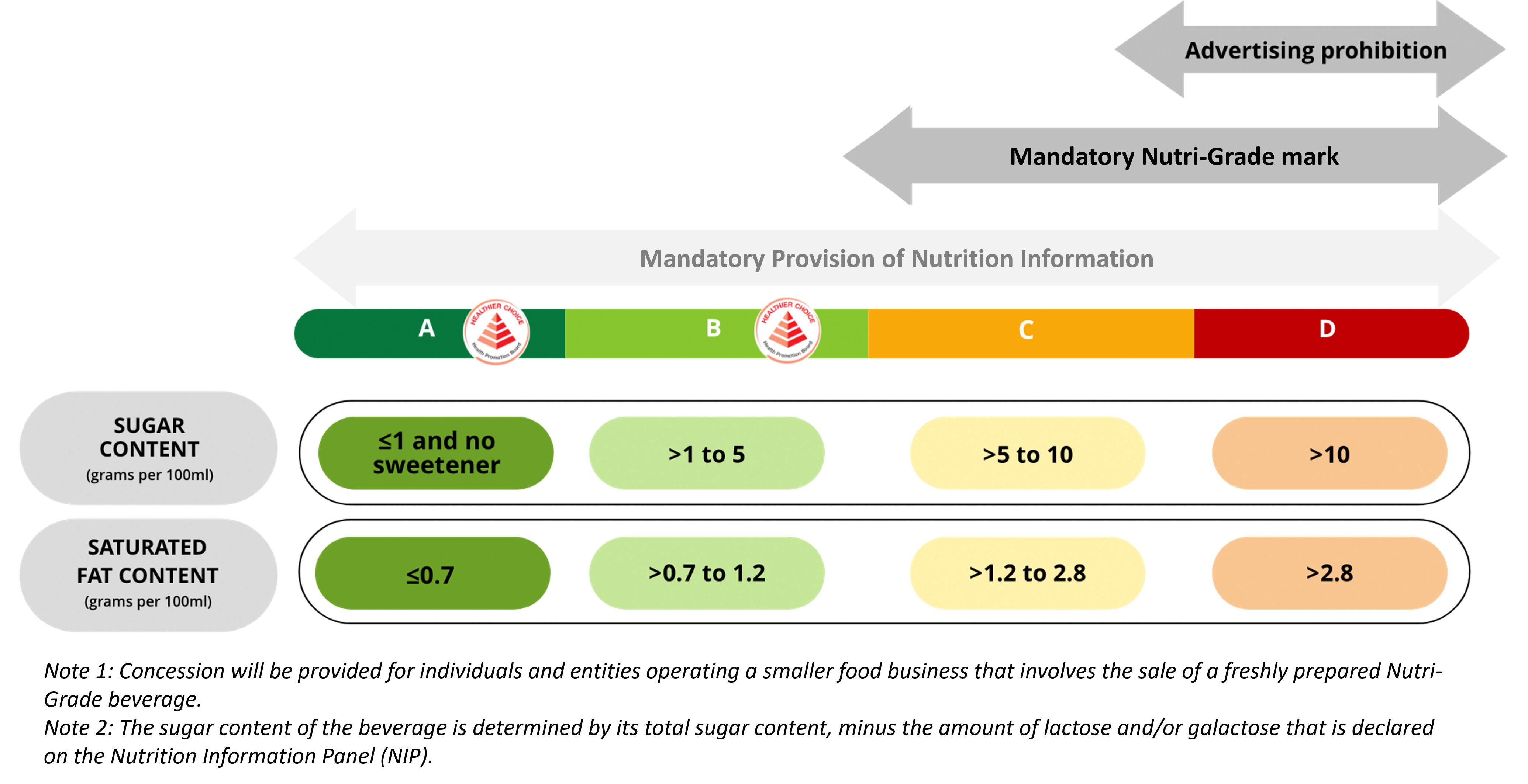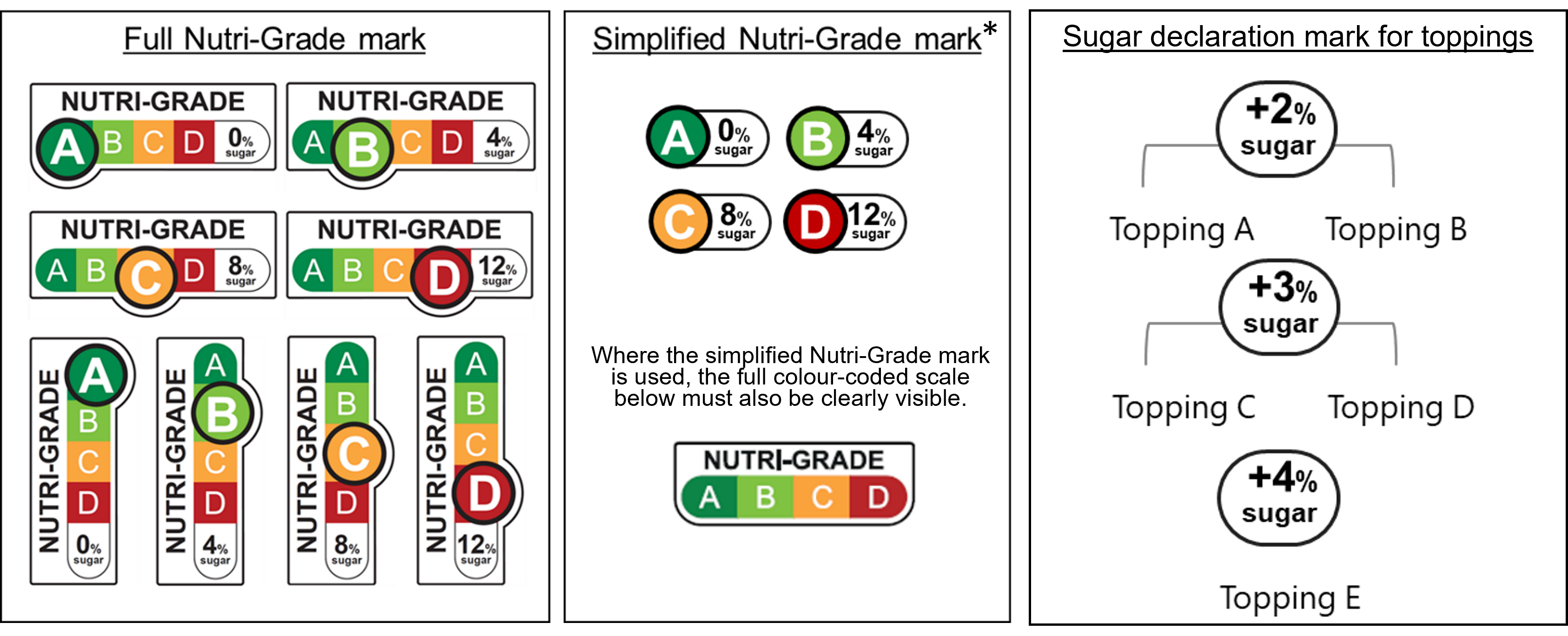This page provides a comprehensive guide for companies on the Nutri-Grade measures and labelling requirements for beverages sold in Singapore. For more information on how consumers can utilise Nutri-Grade to make more informed drink choices, click here.
*NEW* Extension of Nutri-Grade measures to key contributors of sodium and saturated fat
Based on past National Population Health Survey results the prevalence of hypertension and high blood cholesterol among Singapore residents remains high, at 37.0% and 31.9% respectively between 2021 and 2022.
From mid-2027, the Ministry of Health (MOH) will extend Nutri-Grade labelling requirements and advertising prohibitions to key contributors of sodium and saturated fat intake. These measures will apply to 23 sub-categories of prepacked salt, sauces, seasonings, instant noodles, and cooking oils (SSSIO) sold in retail settings.
Key features of the extended measures include:
(a) Differentiated grading system for SSSIO products
SSSIO products must be graded “A”, “B”, “C”, “D”, according to the Nutri-Grade grading system, which is based on the levels of nutrients of concern within each product sub-category.
Products will be graded along the spectrum from the lowest (Grade A) to highest (Grade D) amounts of nutrients of concern, based on a differentiated grading system, which defines specific thresholds for each product sub-category. This grading system encourages reformulation within each product sub-category while preserving the diversity of SSSIO products.
Similar to beverages, products that are graded “C” or “D” must display the Nutri-Grade label on the front-of-pack of product packaging, and online listings of products. Labelling of products graded “A” or “B” will be optional.
(b) Update to the Nutri-Grade label
The Nutri-Grade label will be updated to call out the nutrient of concern that results in the product's final grade, whether it is the primary or secondary nutrient. This helps consumers better understand the basis behind the products' grade, to make more informed choices. The updated label design will also apply to beverages.
(c) Advertising prohibitions for SSSIO products graded “D”
Similar to beverages, advertisements promoting the sale of SSSIO products graded “D” will be prohibited to reduce the influence of advertising of these products on consumer choices. This will apply to advertising across both the online and physical spaces.
To ensure that the Nutri-Grade measures are practicable and feasible, MOH/HPB conducted further consultations with relevant industry, expert and public stakeholders, to seek views on the specifications. A summary of key comments and MOH/HPB's responses can be found here.
A summary of the specifications for the Nutri-Grade extension, including scope of products as well as grading thresholds can be found here, as early reference*, to support industry in commencing their reformulation efforts.
* Please note that the specifications are subjected to World Trade Organisation (WTO) consultations and pending gazettal. For clarifications, please write in to Nutri-Grade@hpb.gov.sg
Measures for Nutri-Grade Beverages
The Nutri-Grade labelling and advertising prohibition measures for beverages sold in Singapore in pre-packaged form and from non-customisable automated beverage dispensers have come into effect on 30 December 2022.
From 30 December 2023, these requirements will be extended to freshly prepared beverages intended for sale at specified settings in Singapore. Additional labelling requirements will also be introduced to beverages under the current Nutri-Grade measures.
On this page:
- Need for Measures
- Details of Measures
- Nutri-Grade calculator
- Resources for Download
- Other references
The Need for Measures
Diabetes is a serious health concern in Singapore. The number of Singapore residents with diabetes is projected to reach one million by 2050, if nothing is done.1 In response to the significant health and societal burden posed by diabetes, MOH launched the War on Diabetes in 2016 to mobilise a whole-of-society effort to tackle the disease.
High sugar intake is linked to increased risk of obesity and diabetes. A 2021 local meta-analysis which included studies on Asian populations found that higher consumption of sugary beverages was associated with a 51% higher risk of diabetes, compared to lower consumption.2 The World Health Organization (WHO) has called on countries to take action to reduce individuals’ intake of sugar to as low as possible, stating that “nutritionally, people do not need any sugar in their diet”.3,4
However, Singaporeans are consuming on average twelve teaspoons (or 58g) of sugar daily.5 More than half of Singaporeans’ daily sugar intake comes from beverages, of which pre-packaged beverages contribute 64 per cent and freshly prepared beverages contribute 36 per cent. More needs to be done to further reduce Singaporeans’ sugar intake.
About the Measures for Nutri-Grade Beverages
The Singapore Government decided to introduce mandatory nutrition labels and advertising prohibitions for Nutri-Grade beverages, after carefully considering the feedback received from public, industry and expert stakeholders, and reviewing existing overseas and local evidence. Together, these measures aim to help consumers identify beverages that are higher in sugar and saturated fat and to reduce the influence of advertising on consumer preferences, thus encouraging more informed, healthier choices and spurring industry reformulation.
The regulations for beverages in pre-packaged form and non-customisable beverages from automated beverage dispensers sold in Singapore, came into effect on 30 December 2022. MOH and HPB have published the additional measures in the Government Gazette on 30 June 2023, to have them come into effect six months thereafter, on 30 December 2023.
The additional measures from 30 December 2023 will apply to freshly prepared and existing Nutri-Grade beverages sold in specified settings, which include (i) retail settings such as food and beverage (F&B) outlets and catering establishments, and (ii) non-retail settings such as hotels, workplaces, educational institutions, healthcare institutions and childcare facilities.
A summary of the new requirements for Nutri-Grade measures can be found within the
MOH press release here. Companies must still refer to the relevant legislation in the
Food Regulations and the
Specifications of the Nutri-Grade mark and Sugar Declaration for the technical requirements for the measures
. The regulations and specifications for the additional measures can be found under "Resources".
“What is considered a Nutri-Grade beverage?”
Nutri-Grade beverages include:
- Pre-packaged beverages that are ready-to-consume and are packed or made up in advance ready for sale in packages such as bottles, cans, cartons, packets or other similar containers
- Pre-packaged beverages that are powders or concentrates that are meant to be reconstituted or diluted with fluids before consumption as a beverage (e.g. 3-in-1 instant coffee beverage, cordials); and
- Non-customisable beverages dispensed from automated beverage dispensers, which are machines that dispense non-prepacked beverages according to a pre-fixed formula, with no option for a prospective consumer of the beverage to customize the amount of any ingredient in the beverage. This includes fountain drinks and beverages dispensed from automated coffee machines.
- [New from 30 December 2023] Freshly prepared beverages that are prepared by hand at the place/premise where they are sold, or those that can be customised by the consumer, such as freshly brewed coffee or tea, freshly squeezed juices, freshly blended smoothies, bubble tea, freshly prepared herbal drinks,
- [New from 30 December 2023] Customisable beverages dispensed from automated beverage dispensers (this includes coffee machines that allow choice of sugar level or creamer).
Alcoholic beverages and special purpose foods are excluded from the definition of “Nutri-Grade beverages”.
Grading System for Nutri-Grade Beverages
All Nutri-Grade beverages will be graded using a single set of thresholds for sugar and saturated fat content (Figure 1).
Figure 1: Nutri-Grade Grading System

The
Healthier Choice Symbol (HCS) and
Healthier Dining Programme (HDP) guidelines are aligned with the Nutri-Grade mark, such that all drinks under the HCS and HDP programmes are either Grade A or B. Explore our Nutri-Grade A & B Drink
Directory.
Mandatory Nutri-Grade mark for beverages graded C or D
The mandatory nutrition label, called “Nutri-Grade”, has four colour-coded grades. Grade A, corresponding to the lowest sugar and saturated fat thresholds, is in green. Grade D, corresponding to the highest sugar and saturated fat thresholds, is in red. Please refer to the Usage Guide in the "Resources" section below, for the specific Pantones.
In addition to the grades, the sugar level of the beverage is shown clearly on the label in the form of percentage of total volume.
Nutri-Grade beverages graded "C" or "D" must be labelled with a Nutri-Grade mark on the front-of-pack of its package for pre-packaged products or [new from 30 December 2023] labelled next to freshly prepared beverages listed for sale, such as on physical or online menus at their point of purchase. Labelling of the Nutri-Grade mark is optional for Nutri-Grade beverages graded 'A" or "B", and companies can choose to label such products with the voluntary HCS or HDP identifier and/or the Nutri-Grade mark.
To better help consumers in their decision making when selecting beverages from menus, a simplified Nutri-Grade mark has been developed and is to be placed next to the individual beverage listings from end 2023. Toppings that can be added to freshly prepared Nutri-Grade beverages, must be labelled with a declaration of sugar content on menus, posters, signs and other materials. The Nutri-Grade and Sugar Declaration for Toppings marks are illustrated in Figure 2.
Figure 2. Illustration of Nutri-Grade mark variants for Nutri-Grade beverages and Sugar Declaration Mark for Toppings

Note: the sugar levels in the images are for illustrative purposes only. The actual sugar level to be indicated on the mark should correspond to the sugar content of each beverage.
Mandatory Provision of Nutrition Information
To facilitate implementation of the measures, all Nutri-Grade beverages are also required to provide its nutrition information, specifying the energy value, the amounts of protein, carbohydrate, total sugar, fat and saturated fat. Additional declaration of other nutrients (e.g. lactose/galactose) is also allowed. Only lactose or galactose declared on the NIP would be subtracted from the amount of total sugar for the purpose of Nutri-Grade grading. Where lactose and galactose are not declared on the NIP, their respective amounts are taken as zero.
Companies are responsible to ensure that the Nutri-Grade mark (if required) and NIP are applied to their products in accordance to the regulations. The images for the Nutri-Grade mark can be downloaded in the “Resources” section below. Companies will not be required to register any product artwork or submit any test result prior to applying the Nutri-Grade mark. Post-market surveillance will be conducted by the relevant authorities to ensure that the regulations are complied with.
Advertising Prohibitions
Advertisements of Nutri-Grade beverages graded "D", are prohibited across all media platforms (e.g. broadcast, print, out-of-home, on-ground, online) except for advertisements of pre-packaged beverages at point-of-sale (POS) platforms within variety shops (e.g., supermarkets, convenience stores). POS advertisements for pre-packaged Nutri-Grade beverages graded "D" are permitted within variety shops (e.g. promotional signage at supermarkets), but these materials must display the beverage’s Nutri-Grade mark clearly.
Brand advertisements that do not feature any particular product, and advertisements that promote the sale of Nutri-Grade beverages graded "A", "B" or "C" are allowed.
Concession for Smaller Food Businesses
To ensure a smooth transition in implementation, we will first provide a concession to individuals and entities running smaller food businesses that involve the sale or supply of freshly prepared Nutri-Grade beverages, if they (i) earn a revenue of not more than S$1 million in the latest financial year, and (ii) sell or supply those beverages at fewer than 10 food premises. This is in view of the challenges such individuals and entities may face, such as a lack of resources to determine the grading of the beverages being sold. We will review this concession over time and make the necessary adjustments.
These individuals and entities will still be required to comply with the measures for existing Nutri-Grade beverages in pre-packaged form and non-customisable beverages dispensed from vending machines and automatic beverage dispensers.
Nutri-Grade calculator
The Calculator is available to help industry and consumers easily determine the grade of Nutri-Grade beverages. The Calculator should always be used in conjunction with the Food Regulations and Industry Guidance Documents, which provide important guidance and explanations.